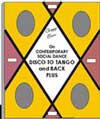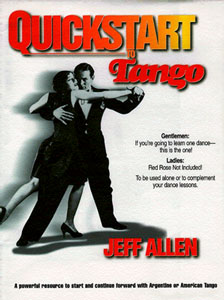| ARGENTINE
TANGO
 In the Philippines, Argentine Tango has earned quite a reputation as the dancer's dance, and with almost everyone presuming to be a good dancer, it's no wonder so many beginners want to learn the Argentine Tango. In the Philippines, Argentine Tango has earned quite a reputation as the dancer's dance, and with almost everyone presuming to be a good dancer, it's no wonder so many beginners want to learn the Argentine Tango.
Of course we are quite familiar
with the characteristics and techniques of AT, yet the Dance Addicts
consider themselves but a few lessons ahead of most local dancers when it comes to Argentine Tango. So sorry guys, we don't have any AT lessons here. Just a summary of characteristics. Though we can probably share with you what we know so far, but we'd rather leave most of the real lessons for the more advanced teachers to handle. One can never become an expert, only more advanced than others in some aspects. So we continue to study and learn and practice.
BETTER TO LINK THAN TO PRETEND
On the web, there are quite a good number of sites which we've found of tremendous help to serious tangueros and
tangueras, providing a clearer understanding of the feel and character of Argentine Tango. But first a taste of authentic Tango music, featuring the piano, bandoleon (accordion), violin, guitar and bass, usually played in milongas '.
(use the control panel to start, pause and stop the
music.)
UNO
(37 KB)
Music by Mariano Mores (1943).
Lyrics by DiscÚpolo.
There are a hundred links to Tango on the web. But the Dance Addict considers the following the best so far:
-
Daniel Trenner stayed in Buenos Aires for 3 years to study the original salon and milonguera tango. He says that "In Argentina the quality of dancing does not depend on how many steps you know. That's because everyone knows so many steps. Only steps that you have invented yourself, that have your signature, get people's attention." Together with Rebecca
Shulman, he writes a number of enlightening articles on less known facts about Argentine Tango.
-
Stephen T. Chin-Bow's
New York
Tango Page is a truly welcome source of insights into Argentine Tango as a dance and as a passion. Stephen's writes with
refreshingly frank candor, enough to dispel any
dancer's illusions and excuses. Read his material to understand what we
mean.
-
Puente al Tango (Bridge to the Tango)
-
Beginner and Intermediate Lessons in Argentine Tango
-
The Dancer's Archive (an FTP site)
-
Frankfurt's Tango Page for other links to the Tango
-
Henry Neeman's Hotlist for the best dance-related sites
(includes this site of course)
-
The Tango List (Discussion of any aspect of the Argentine Tango) which is a discussion group to which
you can join, or simply 'listen' in. To subscribe, send an e-mail to LISTSERV@MITVMA.MIT.EDU with the
message in the body "Subscribe TANGO-L digest Yourfirstname Yourlastname" without the quotes of course.
A few other links are also interesting reading.
Introduction to AT

|
Can't help but comment:
Many local dancers
believe that the dance Argentine Tango, one has to have a regular partner, otherwise they won't be able to execute the moves. THE DANCE ADDICT VIOLENT REACTS. Only dancers who don't understand the essence of social dancing (and of leading and following) will say this. Argentine Tango imbibes the real essence of social dancing and full
dialogue between dance partners. Steps are never memorized, they are led and followed.
Both partners improvise as they go along. AT dancers are equal; they are real dance partners. |
Learn
more about the Universal Unit System from Ms. Skippy Blair's
DISCO TO TANGO
and BACK PLUS


Jeff Allen's
Quickstart to Tango
is a 'how to' of Argentine & American Tango, and contains
discussions on Technique, Exercises, Choreography & Attitudes for both Tango
styles.
Filipino dancers will likely find this book the next best thing to studying
Argentine Tango from a video or with a good teacher.
|
